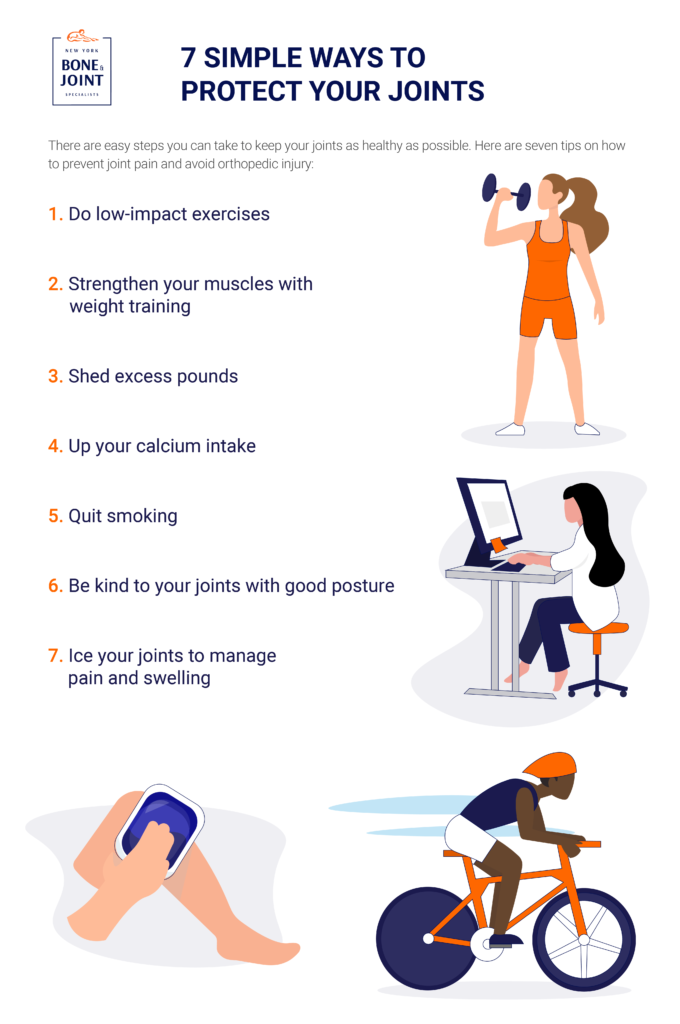Learn seven simple ways to keep your joints strong and pain-free.
Did you know you have between 250 and 350 joints in your body? With these joints, you’re able to walk, climb stairs, shake your hips, and wave hello. Given how much we use our joints, it’s normal to feel occasional joint pain, either from an injury or simply overdoing it after strenuous exercise.
However, there are simple steps you can take to keep your joints as healthy as possible. In this guide, we offer tips on how you can prevent joint pain and avoid orthopedic injury.

7 Ways to Protect Your Joints
Your joints are protected by layers of cartilage that act as a cushion for the bones. When this cartilage wears down, the bones begin to grind together, resulting in joint pain and potentially arthritis.
If you want to keep your joints in good shape for the long term, you can start now by taking measures that prevent damage. Here are seven proven ways to ensure your joints stay strong and pain-free:
- Do Low-impact Exercises. When it comes to joint health, not all workouts are created equal. High-impact exercises such as running and step aerobics can stress the hip and knee joints. Instead, try low-impact aerobic exercises that reduce the strain on your joints. These include biking, swimming, and walking. Plus, before you plunge into your workout program, be sure to stretch and warm up your muscles.
- Strengthen Your Muscles. Weight training is vital for strong joints. Building up the muscles and tendons surrounding your joints provides them with the support they need to do their job. Before you start a weight-training program, ask a physical therapist to demonstrate exercises that will be less stressful to your joints.
- Watch Your Weight. Every extra pound you carry adds additional pressure to weight-bearing joints, particularly the hips and knees. Shedding excess pounds decreases the burden on your joints.
- Up Your Calcium Intake. Eating a diet rich in calcium keeps your cartilage and bones strong. Dairy products (milk and yogurt top the list) and vegetables including broccoli and kale are all good choices. If you don’t think you’re getting enough calcium in your diet, you can also try a calcium supplement. To help your body absorb calcium, make sure to consume the proper amount of vitamin D.
- Quit Smoking. Cigarette smoking contributes to bone loss, which could eventually lead to osteoporosis and fractures. Quit smoking now to preserve your bone mass and joint health.
- Be Kind to Your Joints. When you lift heavy objects, use both arms and hold the item close to your body to alleviate the stress on your joints. Bend at the knees, not at your back. In addition, maintaining good posture when you sit or stand helps support your joints.
- Ice the Pain. If you prefer not to take pain medication, icing the joint can manage occasional joint pain and swelling. Put some ice in a towel and apply it to the joint for 20 minutes.
If you’re recovering from joint surgery or are experiencing persistent joint pain, consult with a physical therapist about which activities and exercises are most beneficial to improve your joint health and mobility. Although you may be tempted to push yourself, remember to slow down if the discomfort becomes severe. A tailored physical therapy program not only preserves your joints, but helps you quickly recover from an injury, as well.
Taking Care of Your Joints
The physicians and physical therapists at New York Bone & Joint Specialists are experts in treating a variety of orthopedic injuries and conditions. If you’re experiencing joint pain, contact us today for an appointment.




